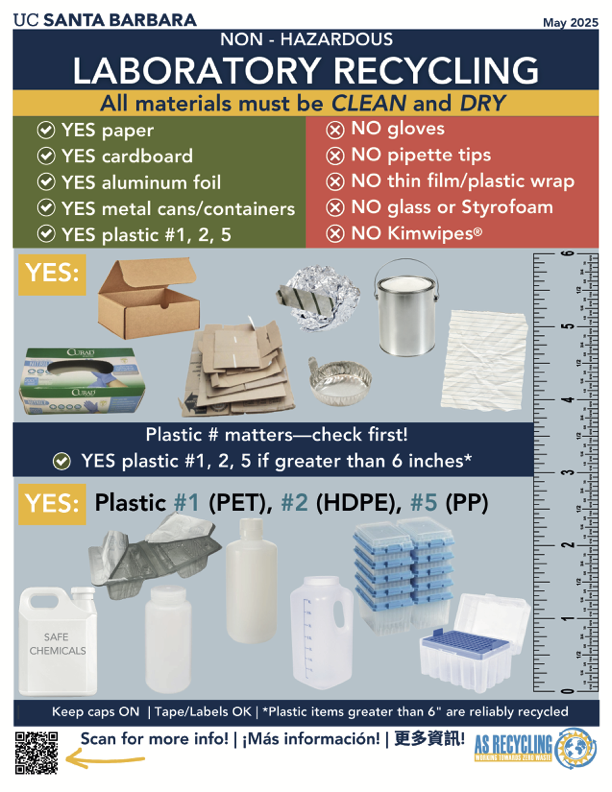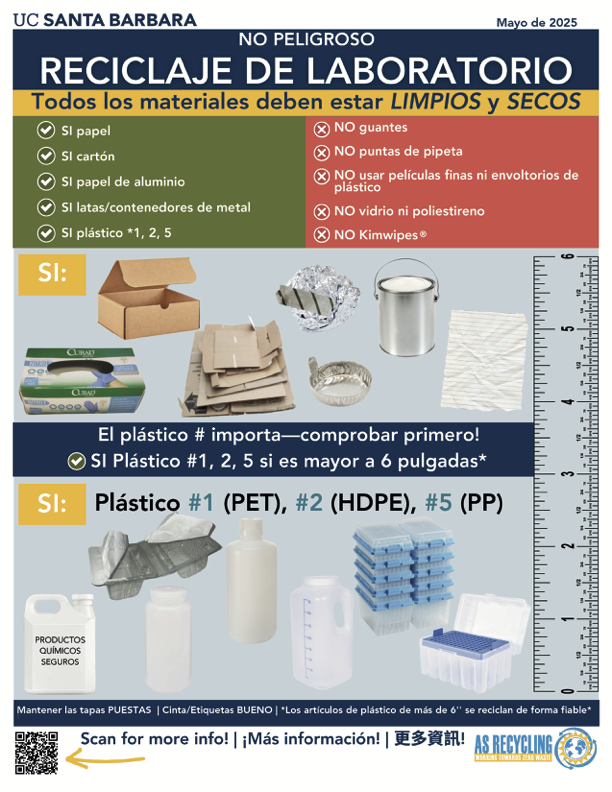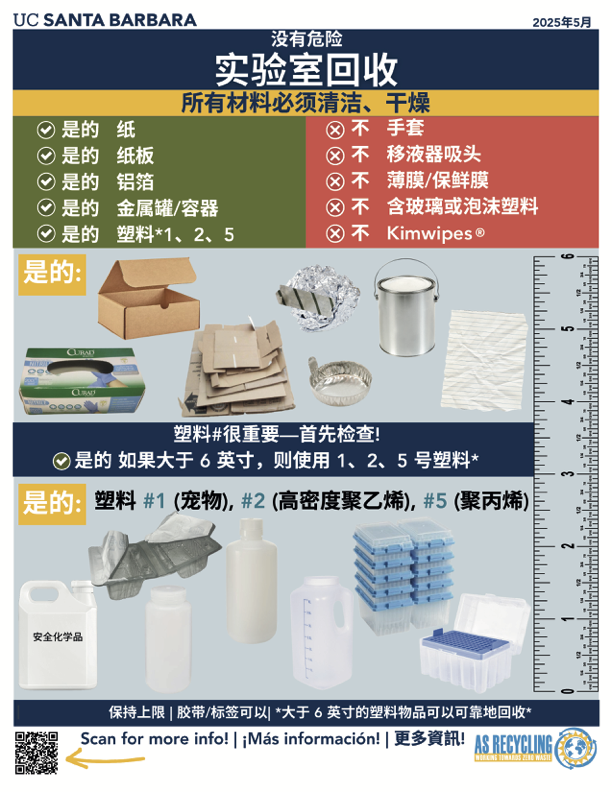This page is dedicated to laboratory-specific recycling practices at UCSB. Research laboratories can reduce their environmental impact by recycling clean, dry, non-hazardous plastics through designated recycling bins. For non-recyclable plastics, labs can support a sustainable research culture and donate materials through UCSB’s partnership with Art From Scrap.
For a guide on what you can recycle in the laboratory space, please see the guides below:



Santa Barbara County Recycling Rules
Currently, plastics #1, #2, and #5 are recycled reliably by Marborg only if they are larger than 6 inches. There is no market for these plastics smaller than 6 inches, so there is no incentive for Marborg to accept these plastics. Since many lab plastics do not meet the 6” threshold, lab personnel can still divert away from the landfill and donate non-recyclable materials for reuse through the low-carbon, no-cost partnership with Art From Scrap.
Recyclability is based on the market, not AS Recycling or Santa Barbara County.
Prior to 2018, far more recyclable items were accepted and sent to China for sorting or disposal. The installation of the “National Sword” ban restricts the import of waste materials including items with high levels of contamination and low quality plastics that are challenging to recycle. In response, many countries had to find new markets and create new recycling programs domestically. Even prior to the ban, only about 9 percent of discarded plastic was truly recycled and 12 percent was burned. Santa Barbara’s Material Recovery Facility helps increase the likelihood of recyclable items being recycled, but doesn’t change which items are possible to recycle. Markets and community differences in fundings and consumption reflect in an area’s local recycling regulations. Each county varies and recycling rules are subject to frequent change.
The Material Recovery Facility is located in the Resource Center of the Santa Barbara Tijiguas landfill, operated by Marborg Industries. The Resource Center was built to address the issue of improper waste sorting and abundance of trash in the landfill. Currently, Marborg Industries identifies 60% of what is buried at Tajiguas landfill as having the potential to be repurposed. This includes organic and recyclable materials. The Materials Recovery Facility at the Resource Center allows speciality sorting of previously wasted material in order to convert it into recyclable materials, landscape nutrients, and renewable energy.
More Information
200,000 tons of waste are buried at Tajiguas Landfill annually, with expected capacity in the next 6 years. Diverting organics and recyclables can help prolong this lifespan.
The MRF uses both automated equipment and manual labor to sort and separate different types of materials based on size, weight, density, and composition. Typically, plastics that are recyclable (1,2,5) need to be larger than 6 inches to be sorted by the MRF.
Compostable organics are sorted out as well, though backyard composting is still the most impactful option. The organics are then taken to an anaerobic digester. The digester’s 16 tunnels reach 104 degrees Fahrenheit to break down the organic trash mixed with 3 percent cow manure into methane and digestate. The Methane is then burned to produce 2 megawatts of power for the Resource Center. Eventually, byproduct is used to create compost.

Common Items Found in the Lab Space: A Guide
| Product | Photo | Eligibility | Plastic # / Material | Notes |
| # 1 – PET (Polyethylene Terephthalate) | Plastic #1 | Recyclable if greater than 6″ | #1 – PET | |
| #2 – HDPE (High Density Polyethylene) | Plastic #2 | Recyclable if greater than 6″ | #2 – HDPE | |
| #3 – V (Polyvinyl Chloride) | Plastic #3 | Not Recyclable | #3 – V | |
| #4 – LDPE (Low Density Polyethylene) | Plastic #4 | Not Recyclable | #4 – LDPE | |
| #5 – PP (Polypropylene) | Plastic #5 | Recyclable if greater than 6″ | #5 – PP | |
| #6 – PS (Polystyrene) (aka Styrofoam) | Plastic #6 | Not Recyclable | #6 – PS | |
| #7 – Other | Plastic #7 | Not Recyclable | #7 – Other | |
| Plastic Packaging (not thin film) [specifically for epT.I.P.S.® Motion as Reload System] |  | Recyclable | The packaging of many of the pipette tip refills is made out of plastic #1. “Delivered in a PET blister packaging.” If clean, dry, and non-hazardous, they are recyclable through MarBorg even if the paper is left on. | |
| epT.I.P.S.® Motion as Reload System paper sealant |  | Recyclable | #2 – HDPE | What about the paper on top? We can’t find the exact material of this paper but it seems to be similar, if not the same, to Tyvek Medical Packaging which is made of HDPE and would be recyclable by MarBorg. Question: Does this need to be fully ripped off to make the plastic packaging recyclable? |
| Plastic (Lab) Wrap |  | Not Recyclable | #1 – PET | Even if clean and dry, this material is NOT recyclable through MarBorg because of the type of material (according to website). |
| Falcon Tube Caps ONLY |  | Not Recyclable | #2 – HDPE | HDPE screw caps are not recyclable by itself. HOWEVER, if the caps are left on falcon tubes greater than 6″, then both the cap and the falcon will be eligible for recycling. |
| Tissue Culture Flask – Vent Cap ONLY |  | Not Recyclable | #2 – HDPE | Tissue culture flask screw caps are not recyclable alone. If these caps are attached to a plastic item that is greater than 6 inches AND is made of plastics #1, #2, or #5 -> then it’s recyclable |
| Nalgene™ Fluorinated Wide-Mouth HDPE Bottles with Closure |  | Not Recyclable because it is smaller than 6 inches | #2 – HDPE | |
| Nalgene® bottles, style 2104 – 500 mL capacity |  | Recyclable as it is greater than 6 inches | #2 – HDPE | |
| Nalgene Bottles (made of Plastic #4) |  | Not Recyclable | #4 – LDPE | Not recyclable since plastic #4 is not accepted by MarBorg |
| Pipetters (the single use ones) |  | Not Recyclable | #4 – LDPE | Not recyclable through MarBorg becuase it is made of plastic #4. |
| Safety Wash Bottles | Not Recyclable | #4 – LDPE | Not recyclable through MarBorg because it is made of plastic #4 | |
| PP Test Tube Rack |  | Recyclable | #5 – PP | If clean, dry, nonhazardous, and greater than 6″ in length, these are recyclable through MarBorg |
| Polypropylene Test/Culture Tubes | #5 – PP | Recyclable through MarBorg as the test tube is 6″ | ||
| Pipette tips (the tips themselves, not any packaging) | Not Recyclable | #5 – PP | Not recyclable through MarBorg because they are too small in size and often contain hazardous material | |
| PP PCR Plates | Recyclable | #5 – PP | If non-hazardous, clean, dry, and larger than 6″ in size, these are recyclable through MarBorg. | |
| Pipette Tip Box ONLY (no red wafer) |  | Recyclable (These can only be recycled IF larger than 6″ in size) | #5 – PP | Check size |
| Colored Plastic Wafer |  | Recyclable (These can only be recycled IF larger than 6″ in size) | #5 – PP | Check size |
| Refill Casette Bases (Inserts for refillable pipette tip box) |  | Recyclable (These can only be recycled IF larger than 6″ in size) | #5 – PP | Check size |
| Colored Plastic Wafer |  | Not Recyclable | #5 – PP | Item is smaller than 6″ threshold, so it is not recyclable |
| USA Scientific TipOne Rack Components |  | Refer to the TipOne Rack Components guide on the left | If the component is made of polypropylene (Plastic #5) and greater than 6 inches, it is recyclable If it is made of “recycled material”, it is not considered recyclable. | |
 | #5 – PP | Clean, dry, and non-hazardous polypropylene (PP) tubes that are larger than 6″ are recyclable through MarBorg even with caps on [lessismore website said caps on is okay even if the plastic # is different] Falcon tubes without caps can be recycled too if size requirement is met. | ||
| Reagent Reservoirs made of Plastic #5 |  | Recyclable (These can only be recycled IF larger than 6″ in size) | #5 – PP | If clean, dry, and non-hazardous, AND larger than 6″ these are recyclable through MarBorg |
| Eppendorf DNA LoBind® Tubes |  | Not Recyclable | #5 – PP | Not recyclable through MarBorg because it is too small in size. |
| Eppendorf Microcentrifuge Tubes |  | Not Recyclable | #5 – PP | Not recyclable through MarBorg because it is too small in size. |
| Cell Culture Plates [Come in 6,12,24,48 well] |  | Not Recyclable | #6 – PS | Not recyclable through MarBorg since it is plastic #6 |
| Styrofoam |  | Not Recyclable | #6 – PS | Not recyclable since plastic #6 is not accepted by MarBorg |
| Polystyrene PCR Plates |  | Not Recyclable | #6 – PS | Not recyclable since plastic #6 is not accepted by MarBorg |
| Petri Dish |  | Not Recyclable | #6 – PS | Not recyclable since plastic #6 is not accepted by MarBorg |
| Polystyrene Test Tubes |  | Not Recyclable | #6 – PS | Not recyclable since plastic #6 is not accepted by MarBorg |
| Polystyrene Weigh Boats |  | Not Recyclable | #6 – PS | Often weigh boats are made of plastic #6 which is not recyclable through MarBorg |
| Celltreat Tissue Culture Flask |  | Not Recyclable | #6 – PS | Made of plastic #6 so they are not recyclable through MarBorg |
| AquaValve® (the feeder for the AquaPak) |  | Not Recyclable | No Plastic # Associated | Polyoxymethylene (POM) plastic AND too small in size |
| AquaPak – water for laboratory animals | Not Recyclable | EVOH | ||
| TipOne Pipette Tip Rack [specifically the blue box (rack) which can be refilled] |  | Not Recyclable | No Plastic # Associated | Blue box can be refilled but when retired, says it is made of “recycled material”. |
| Thermo Scientific™ Nalgene™ PMP Plastic Graduated Cylinders |  | Not Recyclable | No Plastic # Associated | Lab plastics can be made of polymethylpentene (PMP), also known as TPX. This plastic is not one listed to be acceptable, so it is not recyclable. |
| Kim Wipe BOX |  | Recyclable | Paper | If dry, the cardboard box can be recycled through MarBorg. |
| Kim Wipes (the actual wipes) |  | Not Recyclable | Paper | |
| Corrugated Cardboard Mailer Boxes |  | Recyclable | Paper | |
| Paper |  | Recyclable | Paper | Recyclable through MarBorg |
| Sticky Notes |  | Recyclable | Paper | Recyclable through MarBorg |
| Aluminum Weigh Boats |  | Recyclable | Metal | Weigh boats made of aluminum are recylable through MarBorg |
| Aluminum Foil |  | Recyclable | Metal | If clean, dry, and non-hazardous, aluminum foil is recyclable through MarBorg Does not matter if crumpled up into a ball or flattened. Crumpling this material into a ball shape may increase recycling potential. |
